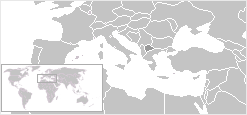Republic of Macedonia represents a part of the entire region Macedonia (also known as Makedonija, Makedonia, Makedonya), a region that contains a great historical - geographical value, in southeastern Europe, in the south central part of the Balkan Peninsula. Macedonia covers about 68,451 sq km. The Republic of Macedonia covers about 25,713 sq km and slightly near than half of the region lies in northern Greece, 34,411 sq km. A small portion of the region belongs to Bulgaria, 6,798 sq km & 802 sq km belongs to Albania. Though mostly mountainous, the region also encompassed the valleys of the Bistrica (Halijakmon), Vardar (Axios) and Struma rivers, all of which drain into the Aegean Sea.
In the 8th century BC the sense of becoming to one nation was improved and the ancient Macedonian tribes formed their ancient kingdom, ruled by Perdica 1st. Philip 2nd, (356-336 BC), led the kingdom into a period of growth and expansion. Philip 2nd conquered the Greeks in 338 BC at the Chaeroneia battle and unified the Greek city-states with the Macedonian kingdom, and they lost their independence. Alexander the Great (336-323 BC), pursued his father's objectives and created a vast empire which stretched south into Egypt and across Persia (now known as Iran) to northwestern India. Culture and art flourished under Alexander's rule.
Alexander The Great, died in 323 BC, leaving the empire with no clear successor. Generals in the Macedonian army divided the empire into smaller kingdoms. These kingdoms continued to fight with each other for several decades until the year 215 BC. Starting in 215 BC Macedonia was assailed by the Romans in a series of three wars which lasted until 168 BC. In 148 BC the region became a Roman province. During the early Christian period the region was an important field for the missionary labors of Saint Paul the Apostle.
After the final division of the Roman Empire in AD 395 Macedonia became part of the Byzantine Empire. In the 6th-7th century the Slavs penetrated in the Byzantine empire in large numbers. The Slavic tribes, Berziti (Brsjaci), Smoljani, Dragoviti, Velegeziti, Sagudati, Rinhini, Strumjani that, settled on the territory of Macedonia mixed with the ancient population and created the Macedonian nation that exists even today. In the 9th century the brothers from Solun (Salonica), Sts. Cyril & Methodius created the first Slavonic alphabet, known as "Glagolica". Their follower, St. Clement of Ohrid, who improved their work, was the founder the of first University of Slavic literacy, in Ohrid (city known as the European Jerusalem). Also, during this period the Archbishopric of Ohrid was established (which became the biggest church on the Balkan's). In 976 AD the medieval Macedonian state was established by the four brothers: David, Aaron, Moses and Samoil, with seat in Prespa & later in Ohrid. After it's fall in 1018, Macedonia was controlled by the Byzantine leader Vasilius 2nd and later by the medieval rulers, as Strez, Dobromir Hriz, Alexi Slav, King Marko and others.
The Ottoman Turks ruled the region for 5 centuries, from 1371 to 1912. In 1767 they forbid the oldest church in the Balkans dating back to the 10th AD, the Archbishopric of Ohrid, (which was restored in 1967 under the name Macedonian Orthodox Church). Their rule was followed by many uprisings: Karpoš in 1689, Neguš in 1822, Razlovci in 1876, Kresna 1878-79 and the Ilinden in 1903, that resulted with the famous ten days, Kruševo republic. The Internal Macedonian Revolutionary Organization (IMRO) was established in Solun (Salonica), in 1893, which goal was establishing an independent Macedonian state.
Unfortunately, after the Balkan Wars (1912-1913), Macedonia was divided among Greece (Aegean), Bulgaria (Pirin), Serbia (Vardar) and small regions were given to Albania (Mala Prespa, Pogradec and Golo Brdo). The division was confirmed, later at the Versailles peace treaty in 1919, after the 1st world war. After this tragic event, the Macedonians were living under triple rule, having no rights of using their mother language and declaring themselves as Macedonians. After the 2nd world war, in 1946 the Macedonians finally got their human rights by having own state, but only on Yugoslav south (in the Vardar part). Those who live in Aegean (Greece), Pirin (Bulgaria), Mala Prespa, Pogradec & Golo Brdo (Albania), still fight for their rights. Macedonia was the last of the Yugoslav republic's, that proclaimed independence on September 8th 1991.



